The Legend of Zelda: The Minish Cap - Small in Scope, Wide in Beauty.
11/05/23
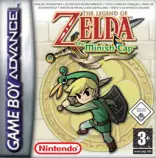
The Legend of Zelda, sans Mario and perhaps Pokemon, is Nintendo’s most *ahem* legendary franchise. A series that has been arguably the definitive title of the vast majority of Nintendo’s many consoles - and it all culminates in the imminent release of The Legend of Zelda: Tears of the Kingdom, a title that truly is looking as if it’ll surpass its genre-defying predecessor. But with all the amazing work Nintendo has done with the series, one can be forgiven for forgetting that they aren’t the sole developers to steer its mainline titles. Yes, we all remember Ocarina of Time, Majora’s Mask, Breath of the Wild… But we must remember the work Capcom, of all people, put into this franchise. Yes, to celebrate the release of The Legend of Zelda: Tears of the Kingdom, I’ll be taking a look at Capcom’s entry in the series for the Game Boy Advance - The Legend of Zelda: The Minish Cap, a disarmingly non-bite-sized entry that stands out for its beauty, it’s celebration of Zelda as a whole, and one of the most addicting sidequests in the series… even if all its parts don’t quite hit the mark.
Man, it’s *crazy* that Capcom are behind genuine mainline entries in the Zelda series. Sure, we occasionally get the odd spin-off here and there, like the Tingle Games, Four Swords Adventure or the *shudders* CD-I games… y’know, I’m surprised Nintendo let *anyone* touch the series after that little era of bangers. Anyway, for some reason, Nintendo contracted Capcom to create a pair of Game Boy Colour titles for the series, Oracle of Seasons and Oracle of Ages. And whilst by all accounts these were strong Zelda games, I never hear people talk about them in the same way I hear about more popular Zelda games. Obviously, though, it’s clear Nintendo were happy with Capcom’s work, as when the Game Boy Advance rolled around, Capcom had another game up their sleeve, a title that surpassed everything they’d achieved in the GBC entries; The Legend of Zelda: The Minish Cap - incredible that the best Zelda game on a console isn’t even from Nintendo, ay?
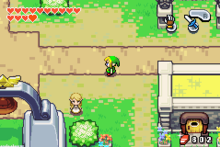
The Minish Cap feels, in general, most like the previous 2D entries in the series, especially The Link to the Past and Link’s Awakening. You’ll be traversing Hyrule, most of which will be blocked off at first, but as you acquire new items in both the overworld and dungeons, like the Flip Rod, Lantern, all Mole Gloves, you’ll slowly uncover new pathways to new horizons. Really, if you’ve ever laid eyes or even touched a 2D Zelda game, you’ll know exactly how The Minish Cap will play out. Minish Cap’s main hook is Link’s ability to shrink down the miniscule size - the size of the aforementioned Minish, a race of plant-loving, fairy-like imps that can only be seen by pure children. Using this size-jumping ability, Link can explore the tiniest crevices and discover an entire world, just hidden beneath the surface, only accessible by the smallest of creatures. Whilst this small, Link is next to useless in combat - at least in more open areas. Being so tiny, puddles become akin to lakes, slightly unkempt grass becomes a solid wall, and otherwise harmless cats and dogs the ultimate apex predator. The dangers of being so miniscule are best encapsulated in the fourth dungeon, the Temple of Droplets, whose main boss fights are actually just totally normal enemies from the overworld Link could devastated in a slice or two, but at Link’s own size, these are amongst the most dangerous foes in the entire game.
Outside of dungeon use, Link’s size-changing is primarily used for puzzles - seeking out miniscule secrets, locating other Minish who’ve made their home in mushrooms, holes, and even the rafters of Hyrule citizen’s homes! Now and then the usage of the ability can feel a little bit samey - y’know, grow little, get in a hole, climb up a bookshelf, etc - but sometimes it’s used to fantastic effect, such as climbing inside a robot’s head to switch it on or off, or sneaking into the back of a shop for an ever-so-elusive Bottle. It’s not the most well utilized ability - especially in the dungeons, which we’ll get to in a moment - but overall, it’s a fun ability that helps stick out from the more by-the-numbers 2D Zelda games of the near past.
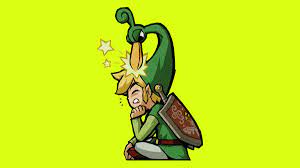
Dungeons are, of course, present in the Minish Cap, though they feel notably more stripped down and transient then previous Zelda games. I’ll be honest, I’m not the biggest fan of the dungeons in this game - I’d never say most of them are bad, just… lacking in one respect or another, moreso with the first half of the game. Truly, the only dungeon I really disliked was the third dungeon, The Fortress of Wind. Beyond having a fantastic boss, where you literally climb inside it to finish it off, I found the dungeon confusing, unintuitive to navigate, and the fact key items are hidden behind breakable, yet non-cracked walls drove me insane. These first three dungeons aren’t particularly interesting, at least in a visual sense. They’re pretty, I won’t lie, but with how similar the second and third dungeons looked, and how the first just takes a more generic ‘forest’ theme didn’t do much for me.
The latter three dungeons were a lot better, especially The Temple of Droplets, which takes place entirely at Minish size and plays a lot around with how ‘normal’ enemies, like Chu Chus and Octorocks, would be like at such a tiny size - also, I love ice themed dungeons, they’re typically my favorite areas in any video game, let alone just Zelda, so I’ll admit I’m biased. I just wish more of the dungeons used the size-changing abilities for more than just minute (heheheh) puzzles - The Temple of Droplets is, in my opinion, the best usage of the ability in the entire game and it just saddens me to see it underutilized otherwise. I did really appreciate the sky dungeon being a much more vertical affair, being more a test of platforming than anything else, which is honestly a pretty rare experience in Zelda as a whole - and the general dreamlike aesthetics of the dungeons are nothing short of fantastic. It’s a little sad that I’m so mixed on these dungeons, since I felt other 2D Zeldas, like A Link To The Past or Link’s Awakening had really strong dungeon design, but here… it varies, heavily. And beyond the fifth dungeon, The Palace of Winds, they all feel genuinely really short, usually being beatable in twenty minutes. Again, for the most part they’re not that bad, but I wish they were just a little bit… more, y’know?
Also, this might be me, but I feel Minish Cap suffers from one of my big gaming pet peeves; I find myself stumbling upon a puzzle, I look at it, mess around with it, before thinking ‘Should I be able to solve this yet?’. This happened a lot in Hyrule Town, where a huge amount of puzzles - many of which involving switching to Minish size - are contained in a relatively small area. Sometimes you just need to push that little bit further in the game, have that specific item, or what have you. Either way, though, it drives me insane to have the reward dangling before me, but there’s just no indication that either I don’t have the tools required to get it, or I’m just too stupid to find the answer. On that note, I felt pretty stupid more than a few times in this game - in one case, it wasn’t talking to a singular Minish (that I SWEAR I spoke to) to open up the library, or not realizing that using the Gust Jar on mushrooms to cross gaps isn’t the only way to use them. I don’t claim to be a smart man - this game isn’t *that* had, overall.
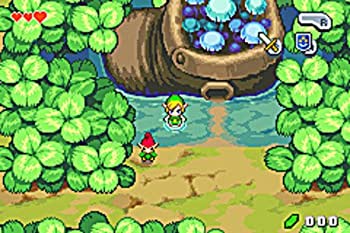
The other notable standout in The Minish Cap is the Kinstone system, and I assure you, there are many, many doubles to find. Scattered around the world, in the grass, in chests, or from enemies, Link will discover Kinstones - little half-medals that each have their own partner held by an NPC in the world. By simply going up to any old character, a thought bubble will emerge if they can fuse a Kinstone. Upon fusing said Kinstone, the world itself will change around Hyrule - a chest will appear, a platforming element will emerge, even entire areas will be unlocked! And whilst none of it is mandatory, you’d be doing yourself a massive disservice from ignoring this addictive little minigame, as you’ll be rewarded with Rupees, Heart Containers, and even a weapon or two! It’s a part of the game that feels rather small, but deep and inherent all the same. Every time I completed a dungeon or checked off another key story event, I’d be racing back to Hyrule Town to stand in each and every NPCs face, praying that the little thought bubble would pop up - preferably with a heart piece in tow! It’s such a neat little system that I kinda wish it came back in a game like A Link Between Worlds - or even Breath of the Wild! Imagine that, helping piece together the broken world of BotW’s Hyrule… using Kinstones!
Honestly, my only real issue with the Kinstone system is the randomness of getting the lowest tier of Kinstones, green ones. They come in three different varieties, but they alone can only be found by randomly killing foes, cutting grass, or other reputable means. As such, they’re the most common Kinstone available to fuse with the denizens of Hyrule, but frequently I found myself obtaining tons and tons of two kinds of Green Kinstones, but all anyone wanted to trade with me were the one I didn’t had, forcing me to pray I’d encounter them just whilst exploring Hyrule. It’s not a huge deal by any means, but considering I just have genuinely no idea what I`` miss by not getting these fusions done, I can’t say I’m not more than a little frustrated when the issue pops up.
With help from the Kinstone system, the amount of little tasks and items to uncover across the overworld gives The Minish Cap perhaps the best overworld of any 2D Zelda. Sure, A Link to the Past might be bigger, and both it and A Link Between Worlds might have their Dark Worlds, but The Minish Cap’s world just exudes a sense of adventure and purity, filled with characters to chat with and secrets to uncover. With each item you find, the world opens up around you, and not just in the main direction you’ll want to be heading to save Zelda, and it can feel ecstatic to dive into the rivers of Hyrule, or uncover an underground cave, making this world feel that much bigger. At first, glancing at the map, I was a little worried; the grid-based map made this game feel miniscule, that I’d find everything and see anything worth seeing within hours, but this game has legs that belie it’s smaller scale; it took me over a dozen hours to wrap my time with The Minish Cap, and that was with a ton of minigames to still play, Heart Pieces to hunt down, and a hell of a lot of Kinstones to fuse. Sure, it’s not as big as its console cousins, but when it comes to an adventure on the GBA, The Minish Cap can’t be beat.
2D Zelda titles are usually a little more scant with storytelling - there’s enough to set up the main conflict and provide context as to why you’re shrinking to tiny size and exploring dangerous dungeons, with a few choice cutscenes peppered in to keep things moving. For once, The Minish Cap’s main foe is not, in fact, Ganon, but another Minish known as Vaati, a fan favorite amongst Zelda fans. Through the power of edge (and this hat he found), Vaati has turned Link’s dear friend, Princess Zelda, to stone, and begins a campaign of searching for the ‘Sacred Force’, prompting Link to seek out the Minish, who can only be seen by children, and who apparently hold the secret to stopping Vaati. Like I said, there isn’t a whole lot to Minish Cap’s story, especially when compared to some of the bigger titles. The bulk of the writing comes from the smaller scale moments - meeting with the King, encounters with Vaati, and the various individuals LInk will bump into as he searches across Hyrule for a way into the half-dozen dungeons that dot the land. And whilst Vaati is a fun villain, the star of the show is without a doubt Ezlo, Link’s sentient hat and the titular cap of the game. Now, normally I despise witty, joke-machine-gun characters like Ezlo, but The Minish Cap’s timing and general usage of Ezlo makes him a fantastic partner character who just perfectly knows when to shut his cotton trap. It’s a fun story, smaller in scale and sillier in tone, but it fits the more whimsical world Capcom have thrown together as their take on the world of Hyrule.
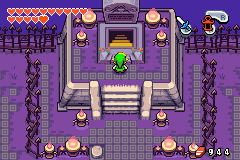
As an aside, in some ways it feels like The Minish Cap is a big celebration of Zelda’s history; you’ve got a huge variety of characters returning from various previous titles, even in minor cameo roles; Anju is in Hyrule Town, tending to Cuccos; Tingle and his ‘brothers’ are out and about, all depicted in their Wind Waker guises; and even the Oracles from Capcom’s own Oracle of Ages/Oracle of Seasons get to make an appearance. Themes are reused, never cheaply, and overall these homages never feel cheap or take away from the identity The Minish Cap has built for itself.
Being one of the later big, first-party titles on the GBA, Minish Cap showcases the best at how the Game Boy Advance can look and sound, and by god, Minish Cap is GORGEOUS. Capcom have always been known for their fantastic sprite art - at least in the mid 2000s - and all that skill is on wide display in The Minish cap. Even if I didn’t love the aesthetics of the first couple dungeons in this game, the atmosphere and general look conjured up by the sprite work is firing on all cylinders. And as the game progresses, it feels like the zones and dungeons grow more and more complex, visually, the peak of which is the fifth dungeon, a gorgeous dungeon in the sky with some of the fluffiest clouds I’ve ever seen in a video game. Seriously, it’s crazy how good this game looks - if I were to conjure up a list of the very best visuals the GBA has to offer, The Minish Cap would be in the top three, easily, and in some ways, it makes me sad that Capcom has kind of moved on from sprite work in general - it was a different types, but in some ways, it was a better time.
Besides some frustrations with its dungeons and the quibbles with Kinstone fusing and Heart Container hunting, The Legend of Zelda: The Minish Cap is a brilliant title and will likely go down as the best non-Nintendo Zelda ever made (so far?). With utterly gorgeous visuals, a chill, entertaining story, an incredibly addictive side quest in the form of Kinstones and what feels like some of the most lovely homages to Zelda games past… Man, it’s crazy that it wasn’t Nintendo behind all this! The Minish Cap is well worth your time - not just for Zelda fans, this is required reading - but for those looking for a solid action-adventure on the Game Boy Advance. Now, if you don’t mind, I have a loooooot of Kinstone fusions to hunt down - I’m due for some good luck, any time now!
Thank you so much for reading my review of The Legend of Zelda: The Minish Cap for the Game Boy Advance! This might be the longest review yet for The Game Boy Abyss, but The Minish Cap is good enough to deserve it. I’m gonna go take a rest; not just because I desperately wanted this review out by Friday, but because I want to sit back and enjoy that very reason itself! Tears of the Kingdom is almost here, and considering how much I loved Breath of the Wild (which I finished mere weeks ago), I think this game is going to be something else entirely. In any case, you can email me at mgeorge7003@hotmail.com if you have any questions or requests. Thanks again for reading, and I’ll see you in a few weeks with something entirely different!
